meanie,
Congratulations - nice build you got there. Understand that your transformers and SLB are in stacked configuration (one on top of the other)?
Congratulations - nice build you got there. Understand that your transformers and SLB are in stacked configuration (one on top of the other)?
Hi zman01,
Yes, Both transformer(300VA) and SLB are stacked up onto one another due to my compact chassis.
Yes, Both transformer(300VA) and SLB are stacked up onto one another due to my compact chassis.
......Thank you ALL for the tips and help along this journey 🙂 The journey is not completed, but I can enjoy the USSA5 as the final details get buttoned up. Time to let the amp settle in and ENJOY 😀
It’s been approximately 6 weeks and many hours of listening since the birth of my USSA5. I’m happy to report that I’ve been able ‘button up the details’.
I used a 1” x 11.5” x 36” plank of walnut hardwood to cut the top and front panels from. I used my Incra box cutting jig, table saw, router w/chamfer bit and sanders to machine the two panels to 1” x 10.5” x 12.5”. A bit of gorilla glue and clamps permanently bonded the two pieces together. Sanding and then 3 coats of Tung oil to finish.
The badge was a home brew attempt at aluminum etching with salt water and DC power 😱 This one was the best of several tries.
The power push-button switch is from TE Connectivity pt# AV1910RB12Q04, it’s illuminated with a bi-color LED. (standby is red/power on is blue)
In order to attach the now one piece of wood to the amplifier chassis and have the power button wires easily accessible I soldered a Molex Minifit Jr. female header to the switch lugs and fabricated a wiring harness with the matching male plug.
The aluminum badge is mounted on 10mm standoffs to give this massive cube a bit of dimensionally to it.
And that’s pretty much the finishing details 😀
As far as listening goes......The USSA5 is a wonderful amplifier, just build it and you will not be disappointed.
Attachments
-
 AE50A2C6-E73A-4C2E-AEA1-D1E475828B9E.jpg1,003 KB · Views: 333
AE50A2C6-E73A-4C2E-AEA1-D1E475828B9E.jpg1,003 KB · Views: 333 -
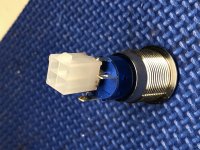 C918B187-2422-420B-B75C-BAF0D0A3AF8B.jpg782.6 KB · Views: 316
C918B187-2422-420B-B75C-BAF0D0A3AF8B.jpg782.6 KB · Views: 316 -
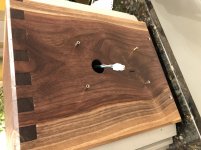 7F515591-2CD4-4CAC-91E9-366C3180D77F.jpg979 KB · Views: 315
7F515591-2CD4-4CAC-91E9-366C3180D77F.jpg979 KB · Views: 315 -
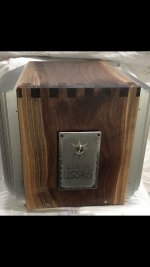 0F5C8C1D-F8E7-454F-A4F2-DF9A270B9AA5.jpg176 KB · Views: 319
0F5C8C1D-F8E7-454F-A4F2-DF9A270B9AA5.jpg176 KB · Views: 319 -
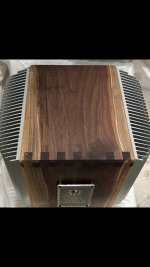 CFA05C62-8BA7-492C-BDD6-3FFA8B14C180.jpg205.3 KB · Views: 305
CFA05C62-8BA7-492C-BDD6-3FFA8B14C180.jpg205.3 KB · Views: 305 -
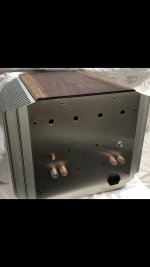 2B779CE0-52F9-4691-BE73-37DABF3946D4.jpg118.8 KB · Views: 196
2B779CE0-52F9-4691-BE73-37DABF3946D4.jpg118.8 KB · Views: 196 -
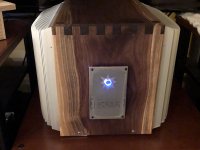 2357B107-FCA7-4F65-98FA-6F0B27D4B60C.jpg788.1 KB · Views: 212
2357B107-FCA7-4F65-98FA-6F0B27D4B60C.jpg788.1 KB · Views: 212
Vunce,
Congratulations!
Just as I had expected, you have a very distinctive looking amplifier.
Nice work with the wood panels; the finger joints add an extra detail that goes well with the overall aesthetic and dimensions.
Congratulations!
Just as I had expected, you have a very distinctive looking amplifier.
Nice work with the wood panels; the finger joints add an extra detail that goes well with the overall aesthetic and dimensions.
Beautiful job there Vunce! I love the wood panels and your badge (it turned out great!).
-Chris
-Chris
Thanks for the kind words Fellas, this was a unique and fun project to work on. In a weird way, I have an unsettled feeling that I do not have another phase of this amp to complete. But, I will get over that rather quickly by having the USSA5 playing in my system 🙂
Thank you Fab for sharing your wonderful amplifier with us!
Thank you Fab for sharing your wonderful amplifier with us!
Hi Vunce,
Beautifully built amp and unique chassis. I really like the dovetail joints on the walnut. Very nice!
Congrats and now enjoy listening to it!

X
Beautifully built amp and unique chassis. I really like the dovetail joints on the walnut. Very nice!
Congrats and now enjoy listening to it!

X
Hi Vunce
This is a very classy amplifier chassis you made. I also like the identification plate...😉
I think your chassis easily classifies for the Solid State pictures build section too..🙂
Fab
This is a very classy amplifier chassis you made. I also like the identification plate...😉
I think your chassis easily classifies for the Solid State pictures build section too..🙂
Fab
Last edited:
Hello Vunce,
Thats amazing build. Something which can be owned for a life time.
congratulations!.
prasi
Thats amazing build. Something which can be owned for a life time.

congratulations!.
prasi
One question about input coupling cap....
I have been playing with the USSPA for a while, i noticed the output can stay below 1mV at idle most of the time. Is it safe to run the USSPA with USSA5 directly without the 4.7uF coupling cap?
When i first build the USSA5, i bypassed the cap, knowing that my Yarra preamp has a coupling cap there. So when i built the USSPA, in all eagerness, i connected the USSPA to the USSA5, forgetting that the cap was not there.
It actually sounds really really good, "capless", now that i put in the 4.7uF, i kind of missed that sounding.
Has anyone runs "capless" in the longer terms? Just worry if i blow up the USSA5!
I have been playing with the USSPA for a while, i noticed the output can stay below 1mV at idle most of the time. Is it safe to run the USSPA with USSA5 directly without the 4.7uF coupling cap?
When i first build the USSA5, i bypassed the cap, knowing that my Yarra preamp has a coupling cap there. So when i built the USSPA, in all eagerness, i connected the USSPA to the USSA5, forgetting that the cap was not there.
It actually sounds really really good, "capless", now that i put in the 4.7uF, i kind of missed that sounding.
Has anyone runs "capless" in the longer terms? Just worry if i blow up the USSA5!
 Ho ho ho ho ,Meanie
Ho ho ho ho ,Meanie I always play my USSA-5 without cap and no protection for hours , my 6V6 Salas preamp it has a cap 0.68uf/1200V at output...Very very stable amp.
Last edited:
Hi meanie,
Unless there is something wrong with the capacitor you will not hear any difference at all. You absolutely should use an input coupling capacitor. If you want the very best, use a new manufacture, commercial Polypropylene or Polystyrene capacitor. The larger the capacitor, the more noise you may pick up. A big capacitor is a big antenna.
Output protection. Do I really have to say this again? Okay, here we go ... again over the years. Sigh.
Output protection should absolutely be used in all amplifiers. No excuses unless the amplifier is transformer coupled, like a tube amplifier for example. You may still want one in that situation just to kill start up and shut down noises.
Right now, using a relay is the most common way to protect your speakers. However, there is work on using power mosfets. I will be testing those for distortion and noise.
If you do not use some sort of output protection, you may well be responsible for a fire. Two weeks ago, an amplifier came in for service that did cause a fire in a speaker. There was +70 VDC across the speaker terminals! A very expensive woofer, part of the crossover and internal padding was all damaged and burned due to this amplifier not having any output protection at all, save maybe a fuse. Just the woofer exceeded the cost of the entire amplifier. The amplifier in this case was an OCM 500.
In the end, I refused to repair the amplifier on the grounds that an output failure was going to reoccur at some point in the future (not enough output pairs and heat sinks). The customer thought about it and agreed with me. One scrapped amplifier.
Another amplifier had no input coupling capacitor and no output protection. This was a while ago. The preamp went DC, so it had a DC output voltage. This was input to the amplifier which happily amplified it (into one rail, clipping). Another speaker's woofer died, and it was a PSB Stratus Gold. I won't mention that the brand of the amplifier and preamplifier was Krell in that case. 🙂
The main complaint against output protection is that the relay contact eventually go bad. Okay, so what? A relay is a maintenance item, just replace it occasionally.
I don't see any excuse that you can stand behind for not having any output protection. In the first case, there was an actual fire. The customer no longer leaves his equipment on all the time. He happened to be listening to some music when this happened. Scary if you think about it. The same holds true for an input coupling capacitor.
-Chris
Unless there is something wrong with the capacitor you will not hear any difference at all. You absolutely should use an input coupling capacitor. If you want the very best, use a new manufacture, commercial Polypropylene or Polystyrene capacitor. The larger the capacitor, the more noise you may pick up. A big capacitor is a big antenna.
Output protection. Do I really have to say this again? Okay, here we go ... again over the years. Sigh.
Output protection should absolutely be used in all amplifiers. No excuses unless the amplifier is transformer coupled, like a tube amplifier for example. You may still want one in that situation just to kill start up and shut down noises.
Right now, using a relay is the most common way to protect your speakers. However, there is work on using power mosfets. I will be testing those for distortion and noise.
If you do not use some sort of output protection, you may well be responsible for a fire. Two weeks ago, an amplifier came in for service that did cause a fire in a speaker. There was +70 VDC across the speaker terminals! A very expensive woofer, part of the crossover and internal padding was all damaged and burned due to this amplifier not having any output protection at all, save maybe a fuse. Just the woofer exceeded the cost of the entire amplifier. The amplifier in this case was an OCM 500.
In the end, I refused to repair the amplifier on the grounds that an output failure was going to reoccur at some point in the future (not enough output pairs and heat sinks). The customer thought about it and agreed with me. One scrapped amplifier.
Another amplifier had no input coupling capacitor and no output protection. This was a while ago. The preamp went DC, so it had a DC output voltage. This was input to the amplifier which happily amplified it (into one rail, clipping). Another speaker's woofer died, and it was a PSB Stratus Gold. I won't mention that the brand of the amplifier and preamplifier was Krell in that case. 🙂
The main complaint against output protection is that the relay contact eventually go bad. Okay, so what? A relay is a maintenance item, just replace it occasionally.
I don't see any excuse that you can stand behind for not having any output protection. In the first case, there was an actual fire. The customer no longer leaves his equipment on all the time. He happened to be listening to some music when this happened. Scary if you think about it. The same holds true for an input coupling capacitor.
-Chris
@nikosokey,
You still have the 0.68uF coupling cap in your salas preamp, so your Ussa5 is protected against DC.
@Anatech,
Thanks for the advise.
I am using those huge boutique caps, I agree that the bigger they are, they gonna pick up more noise. I will try changing to the smaller bipolar Wima poly caps for input protection, it make sense to protect the back end not killing the speakers. I am using SSR for speakers protection at the moment.
You still have the 0.68uF coupling cap in your salas preamp, so your Ussa5 is protected against DC.
@Anatech,
Thanks for the advise.
I am using those huge boutique caps, I agree that the bigger they are, they gonna pick up more noise. I will try changing to the smaller bipolar Wima poly caps for input protection, it make sense to protect the back end not killing the speakers. I am using SSR for speakers protection at the moment.
Hi Fab
I finished my amp boards and was planning to do the initial setup testing but realized that my transformer of 0-18v 7a is being used in my M2X amp 🙂. So I am planning to order a new one and slightly more VA like this:
Toroidal is what I am planning unless a RCORE makes a difference
PRIMARY : 0---230 VOLT. With Shield
SECONDARY :
0---19 V./ 10.5 Amp.
0---19 V./ 10.5 Amp
0---12 V./ 1 Amp. (speaker protection and VU meter powering)
I hope this transformer is good enough for the USSA-5 amp.
Thanks
I finished my amp boards and was planning to do the initial setup testing but realized that my transformer of 0-18v 7a is being used in my M2X amp 🙂. So I am planning to order a new one and slightly more VA like this:
Toroidal is what I am planning unless a RCORE makes a difference
PRIMARY : 0---230 VOLT. With Shield
SECONDARY :
0---19 V./ 10.5 Amp.
0---19 V./ 10.5 Amp
0---12 V./ 1 Amp. (speaker protection and VU meter powering)
I hope this transformer is good enough for the USSA-5 amp.
Thanks
Manniraj,
Greetings!
You are planning to use a single power supply board in your USSA-5? It is possible to run the amp with a single PSU, but if I am not wrong, dual mono is preferred.
For that you will need 2 power supply boards, and 2 transformers with 2X secondaries each. The transformers can be smaller - say 5-6 amperes per secondary should be adequate.
If your transformer winder can manage, a single large transformer with 4 x secondaries of 0-19V, each rated at 5-6 amperes would be good also for 2 power supply boards.
Your secondary voltages look correct if you are planning to use a CRC type power supply like the one in the diyAudio store.
What power supply do you have in mind currently?
Greetings!
You are planning to use a single power supply board in your USSA-5? It is possible to run the amp with a single PSU, but if I am not wrong, dual mono is preferred.
For that you will need 2 power supply boards, and 2 transformers with 2X secondaries each. The transformers can be smaller - say 5-6 amperes per secondary should be adequate.
If your transformer winder can manage, a single large transformer with 4 x secondaries of 0-19V, each rated at 5-6 amperes would be good also for 2 power supply boards.
Your secondary voltages look correct if you are planning to use a CRC type power supply like the one in the diyAudio store.
What power supply do you have in mind currently?
Hi Fab
I finished my amp boards and was planning to do the initial setup testing but realized that my transformer of 0-18v 7a is being used in my M2X amp 🙂. So I am planning to order a new one and slightly more VA like this:
Toroidal is what I am planning unless a RCORE makes a difference
PRIMARY : 0---230 VOLT. With Shield
SECONDARY :
0---19 V./ 10.5 Amp.
0---19 V./ 10.5 Amp
0---12 V./ 1 Amp. (speaker protection and VU meter powering)
I hope this transformer is good enough for the USSA-5 amp.
Thanks
I would strongly recommend dual mono. However, your planned secondary current delivery is easily enough.
RCore would be fun to try and compare it in the design with a toroid. As Fab states on page 26 of the manual, the PSU is critical. This is something that is often overlooked in these builds.
Cheers,
Greg
- Home
- Amplifiers
- Solid State
- USSA-5 Build with Review